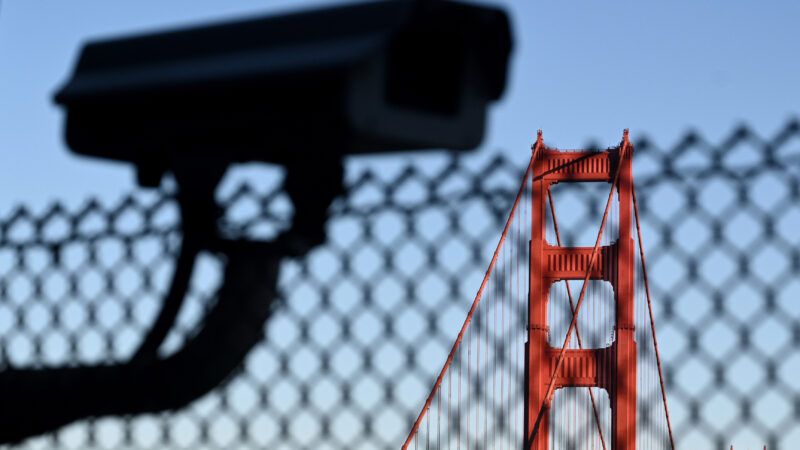San Francisco Police Spent 193 Hours Over 3 Months Watching Private Surveillance Footage
The surveillance yielded 49 arrests, of which 42 were for possession or sale of narcotics.

In 2022, the San Francisco Board of Supervisors passed an ordinance that would allow the city's police department to access footage from private security cameras under certain circumstances. A new city report sheds light on just how much the police have used the privilege.
Between 2021 and 2022, news reports depicted a wave of "smash-and-grab" retail thefts across California. San Francisco Mayor London Breed complained that city policy did not allow police to access security camera footage during emergency situations. "Where there were multiple robbery crews hitting multiple stores, [police] couldn't even access those cameras, which is ridiculous," Breed said in December 2021.
"There is a balance to be had, I know," she noted. "But right now, if our officers cannot use cameras during a mass looting event, then that policy is out of balance."
The following year, at Breed's urging, the city government implemented a 15-month pilot program in which the San Francisco Police Department (SFPD) could "temporarily live monitor activity during exigent circumstances, significant events with public safety concerns, and investigations relating to active misdemeanor and felony violations." Investigators would need the camera owner's "express consent," but they could access the feed live for up to 24 hours after receiving access.
As part of the ordinance, the SFPD would compile quarterly reports detailing how many times it requested access to video footage and for how long. The report released in January shows that in the third quarter of 2023, covering July through September, SFPD made 34 requests to view private footage, all of which were approved. All told, 51 officers and 13 sergeants spent a collective 193 hours and 19 minutes monitoring live surveillance footage—the equivalent of more than eight full days in a three-month period.
Despite being touted as a method to disrupt mass retail theft, 29 out of the 34 requests were for narcotics investigations. Police made 49 arrests as a result of surveillance, of which 42 were for narcotics—including possession or sale of opiates, heroin, methamphetamine, etc.—while two were for homicide, four were for "theft/larceny," and one was for "delaying, or obstructing peace officer duties" in connection with possessing or receiving stolen property.
Interestingly, all of the requests stemmed from just five census tracts—plots of land that cover about 4,000 residents on average.
The report is anonymized, excluding any information about the camera owners "to decrease the likelihood that they may face retaliation related to criminal investigations." But there is still enough to be able to draw certain conclusions.
"By far the longest monitoring session was during the Outside Lands Music Festival in August in Golden Gate Park, when officers watched 42 total hours of live footage," the San Francisco Chronicle noted in its review of the available data. "Police were able to make five arrests for theft, pickpocketing and resisting an officer during that time, but it's unclear what other use police had for the nearly two consecutive days of live media feeds during the festival."
Further, "only one of those five arrests led the district attorney's office to file charges."
Proponents may point to the arrests as evidence of the policy's success, even apart from the two homicide suspects. Immediately after taking office in 2022, District Attorney Brooke Jenkins backed Breed's proposal for what became the pilot program. "This policy can help address the existence of open-air drug markets fueling the sale of the deadly drug fentanyl," Jenkins noted. "Drug dealers are destroying people's lives and wreaking havoc on neighborhoods like the Tenderloin," one of the five census tracts represented in the report.
But it's not clear whether the same results could have been achieved without giving police real-time access to private cameras.
"The need for greater transparency…is crucial to truly evaluate the impact that access to live surveillance has had on policing," write Saira Hussain and Matthew Guariglia of the Electronic Frontier Foundation. "In particular, the SFPD's data fails to make clear how live surveillance helps police prevent or solve crimes in a way that footage after the fact does not."
But rather than erring on the side of caution, San Francisco is openly embracing further surveillance: The city is rolling out new traffic cameras, which are more effective at filling government coffers than preventing traffic fatalities.
Next month, city residents will be able to vote on Proposition E, which would "permit the [SFPD] to use Surveillance Technology for at least one year" before the city government could disallow it. As one city employee said at a November 2023 meeting of the Board of Supervisors, the SFPD would "have a one-year pilot period to experiment, to work through new technology to see how they work," apparently making San Franciscans into guinea pigs for the surveillance state.
Show Comments (24)